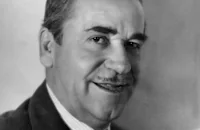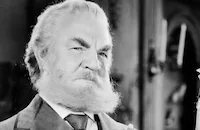The Big Stampede

Brief Synopsis
Cast & Crew
Tenny Wright
John Wayne
Duke
Noah Beery
Paul Hurst
Mae Madison
Film Details
Technical Specs

Synopsis
When potential settlers in the territory of New Mexico are harassed by cattle rustlers, Governor Lew Wallace sends deputy sheriff John Steele to straighten out the problem. John quickly discovers that the leader of the rustlers is Sam Crew, who poses as a prosperous business man. John pretends to be a drunken drifter in order to secretly watch Crew. Crew welcomes a group of settlers that includes Ginger Malloy, her small brother Pat and her uncle, Cal Brett, but later sends his men to steal their cattle. During a gunfight between the settlers and the bandits, a rival gang led by Sonora Joe steals the cattle and Cal is killed. With the help of his horse "Duke," John retrieves the cattle and enlists Sonora's help against Crew. He announces that, as deputy sheriff, he will arrest Arizona, Cal's killer, precisely at nine o'clock, and with Sonora's help, he does. The gang plans to rescue Arizona when he is transferred to the fort for trial, but John uses a ruse to thwart their plans. Meanwhile, the settlers drive their cattle to the fort where they plan to sell them, and Crew decides to stampede their cattle drive. John once again rescues the cattle, and Crew is trampled to death by the herd. Now that Crew is gone, the settlers can live peacefully, and John and Ginger plan to marry.

Director
Tenny Wright
Cast

John Wayne
Duke

Noah Beery
Paul Hurst

Mae Madison
Luis Alberni

Berton Churchill
Sherwood Bailey
Lafe Mckee
Joseph Girard
Crew

Film Details
Technical Specs

Articles
The Big Stampede
This was the case with The Big Stampede, directed by Tenny Wright and starring John Wayne in a 1932 remake of a movie made just five years prior, in 1927, as The Land Beyond the Law, starring Ken Maynard and his horse, Tarzan. Much of the earlier stunt footage of Ken and Tarzan was used to double for John Wayne and his horse, Duke. Both horses were white and doubling Maynard for Wayne was simply a matter of dressing up Wayne in the same clothes that Maynard wore for the shots to be inserted. Unfortunately, the film stock doesn't match very well and the film speeds match even less well. The footage taken from the 1927 picture moves at several more frames per second than the 1932 footage making it stand out a bit. However, this being a Warner Brothers quickie intended to bolster Wayne's career, it's not really that unfortunate after all.
Edited down to a brisk 53 minutes, it's only slightly longer than a present day television episode sans commercials. The purpose was to make money efficiently and quickly and move on to the next one. Along the way, they would sometimes make a movie that actually stood up as an entertainment long after the repurposed footage served its purpose. The Big Stampede is one of those and remains one of the Duke's (John, not the horse) better early pictures.
The story begins with a letter sent to the Governor asking for help with cattle rustlers. The governor pledges to send his best man, Deputy Sheriff John Steele (John Wayne), to take care of it. Meanwhile, we see those same cattle rustlers bringing in 200 head of cattle while cold bloodedly killing a man who was following them. That's when they get word, simultaneously, of a Deputy coming to town and a new herd, up to 5,000 head of cattle.
Steele arrives in town and pretends to be a drunken drifter so he can stakeout the situation and see what's what. The town's top businessman, Sam Crew (Noah Beery), welcomes the new cattle ranchers while, unknown to the townspeople, is behind the rustling himself. This sets up a confrontation with another cattle rustler and John Steele as all three close in towards a final confrontation.
Like many B-movie westerns of the early thirties, The Big Stampede is packed with talent, including actors that would go on to greater fame. John Wayne obviously went on to bigger fame but some of the actors in The Big Stampede are famous even if their names aren't. Paul Hurst, for instance, had success in The Ox-Bow Incident (1943) as a cruel vigilante but his greatest success, known the world over, is that of the Yankee soldier who gets his face blown off by Scarlett O'Hara in Gone with the Wind (1939). Few people know the actor in that role but no one who sees the movie can ever forget the moment, one of the earliest examples of full-color gore in the movies, albeit for only a frame.
Also in the cast is Berton Churchill, playing the governor. Churchill would act again with John Wayne in a movie that would put both on the map of Hollywood in a way unimagined by them in 1932. The movie was Stagecoach (1939), with Churchill as the crooked banker and Wayne as The Ringo Kid. Tragically, Churchill would die the very next year, cutting short an even greater character actor career that would have emerged after Stagecoach than he already enjoyed.
Finally, there's the great Noah Beery. Looking every bit the brother of the equally imposing Wallace Beery, Noah had the same gruff demeanor, the same booming voice, the same powerful presence. He never won an Oscar like his brother and never achieved the same name recognition but he was every bit the actor, despite a career in B-movies that his brother never suffered through.
John Wayne would eventually move up and out of the quickie horse operas of the thirties, and leave behind Duke, when he got that pivotal role in Stagecoach, but that doesn't mean he didn't make a lot of entertaining fare along the way. The Big Stampede is one of them. With its impossibly short running time and brisk pacing, it's not a heavy commitment to make and one that will leave the viewer with an appreciation for the economy of early Hollywood entertainment.
Director: Tenny Wright
Producer: Leon Schlesinger, Sid Rogell
Screenplay: Kurt Kempler, Marion Jackson (story)
Cinematography: Ted D. McCord
Music: Bernhard Kaun
Film Editor: Frank Ware
Cast: John Wayne (John Steele), Noah Beery (Sam Crew), Paul Hurst (Arizona), Mae Madison (Ginger Malloy), Luis Alberni (Sonora Joe), Berton Churchill (Governor Wallace), Sherwood Bailey (Pat Malloy), Lafe McKee (Cal Brett), Joseph W. Girard (Major Parker), Duke (Duke)
By Greg Ferrara
SOURCES:
Wikipedia
IMDB

The Big Stampede
Quotes
Trivia
Notes
This film marked Tenny Wright's first film as director. According to the file on the film at the AMPAS Library, John Wayne performed all his own stunts. Modern sources list Frank Ellis and Hank Bell among the cast. This was a remake of the 1927 First National production The Land Beyond the Law, which was directed by Harry J. Brown and starred Ken Maynard (see AFI Catalog of Feature Films, 1921-30; F2.2952). Warner Bros. produced another film in 1937 based on the same source, entitled Land Beyond the Law, which was directed by B. Reeves Eason and starred Dick Foran (see below).

Miscellaneous Notes
Released in United States 1932
Released in United States 1932














